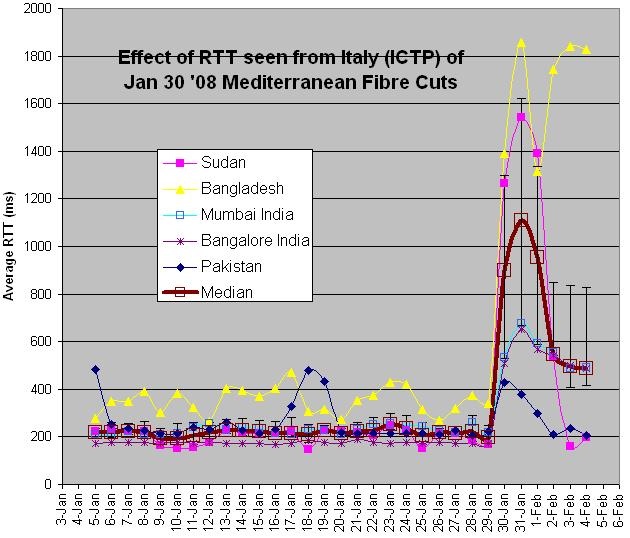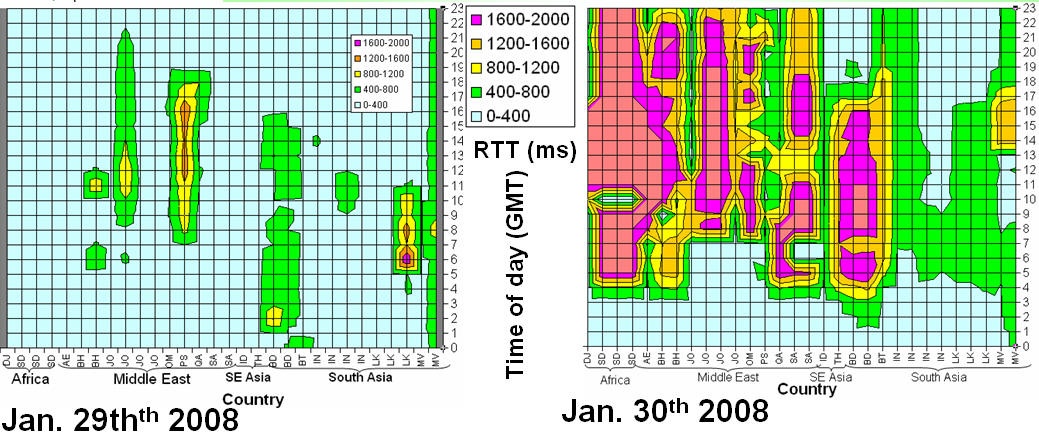...
To illustrate that the effects are also seen from elsewhere than SLAC in California, in the Figure below we show time series of the average RTT seen from the International Center for Theoretical Physics (ICTP) in Trieste Italy to a few of the hosts in some of the affected countries. It is not clear that the Pakistani host's increase in RTT was an effect of the outage or just normal variation (see Jan-18 and 19 for this host), it is therefore not included in the median shown. It also appears that Sudan recovered after 3 days while India was still recovering after 6 days, and there is no evidence that the Bangladesh host was recovering at all.
The close tracking of the curves for both Indian hosts suggests they were using similar providers and routing.
It also needs to be stressed that not all hosts in all countries were impacted, e.g. India: 2 of 8; Sri Lanka 3 of 5; Malvinas 3 of 5; Indonesia 1 of 7; Turkey: 1 of 3; Thailand 1 of 6. On the other hand all monitored hosts were impacted in: UAE(1), Bangladesh(2), Bahrain(2), Djibouti(1), Jordan(4), Oman(1), Qatar(1), Saudi Arabia(2). The numbers in parentheses are the number of hosts monitored. The list of countries in this region that have PingER monitored hosts, but none of the monitored hosts were noticeably impacted is also interesting. It includes: Egypt, Ethiopia, Iran, Israel, Lebanon, Pakistan, Palestine, Sudan, Central Asia, the Caucasus and East Asia. Some of these were lucky that they did not make major use of either of the two cables (e.g. Palestine is mainly served by SEAMEWE3), others had totally different routes from SLAC (e.g. via the Pacific for East Asia), others such as Israel had other alternate paths, other used satellite (e.g. Central Asia). We also did not observe complete loss of connectivity, associated with the outage, for any host.
Looking in more detail at the impact hour by hour on January 30th we get the map on the right in the Figure below. It shows the hourly average RTTs (z axis) by time of day (y axis) on January the 30th from SLAC to 30 impacted hosts (x axis) in 17 countries identified by their Top Level Domain (TLD). In this graph the vertical (Average RTT) is chopped off at 2 seconds, though some hosts took up to almost 10 seconds to respond at times. It can be seen that the impact (sudden increase in RTT) is very abrupt. The time of the impact varies by 2-3 hours (between 4am and 7am). Most hosts continued to respond apart from 3 in Sudan and 1 in Bahrain, each of which did not respond for up to an hour. The magnitude of the impact also varies by more than an order of magnitude from country to country. By looking at the data for other days in particular Jan 29th (see the map in the left of the Figure below), we verified that the sudden increase was not caused by the normal diurnal variations of people coming to and leaving work etc.
We also looked at the losses as a function of time, see the Figure below. The numbers in each cell are the rough losses (rounded off to ahat not all sites in a country were equally affected. For Bahrain one of two sites were affected, India 2 out of 4, Jordan 3 out of 4, Sri Lanka and the Maldives none were affected. Sites in some countries such as Jordan and Bangladesh took more than 5 days to recover, for India 2 sites took 4 days to recover.
...


